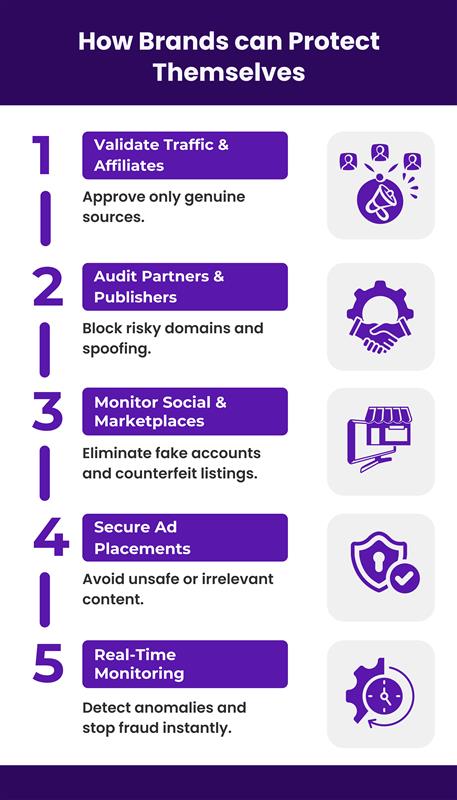The US holiday season 2025 is fast approaching, and ecommerce brand is gearing up to capture every opportunity to reach their target audience. In a highly competitive and oversaturated market, it’s not just about attracting the right customers, it’s about retaining them and ensuring meaningful engagement. With the U.S. accounting for nearly 10% of global ecommerce, the scale and influence of the American ecommerce market make it clear why brands are focusing their strategies here to maximize holiday sales and ROI.
This Holiday season opens the opportunities, but scammers are racing to exploit the surge in ads, holiday campaigns, and offers, and consumer urgency, making brands prone to market vulnerabilities like ad fraud and phishing attacks. They gradually exhaust brands’ ad budgets, impacting reputation and eventually impacting growth.
In this blog, you will discover:
- Why brands are more prone to scams during the holiday season
- How Holiday Brand Campaigns Are at Risk of Ad Fraud
- Holiday Season Threats Beyond Ad Fraud: Brand Misuse and Counterfeits
- Domino Effect of Ad Fraud and Brand Infringement
- How to Safeguard Your Ecommerce brand from Holiday Fraud and Threats
- Quick Pre-Holiday Safety Checklist for ECommerce Marketers
Why Brands are More Prone to Scams during the US Holiday Season
As US e-commerce enters the holiday season, rising ad spends and shopper activity create prime opportunities for fraudsters to exploit. Let’s know why –
1. Surge in Ad Budgets
Marketers ramp up their digital ad budgets to capture the attention of customers who are willing to spend more in the US holiday season. They run multiple campaigns on various sites, attracting massive holiday traffic, and making it easier for fraudsters to blend their fraudulent activities in the process.
2. Performance Pressure
Holiday season creates a performance pressure on brands that release their marketing campaigns. This urgency to capture customer attention may often lead to ads being exposed to unsafe ad placements, invalid traffic, and even hijacking of organic traffic.
3. Impulsive Clicks on Attractive Deals
Fraudsters use “too good to be true” offers as a prey to attract customers, enabling them to click on the advertisement and redirect them to fake sites, harvest data, or generate fake conversions, all while damaging the brand’s trust and reputation.
4. New Affiliates and Networks
During the peak US holiday season, when brands onboard new affiliates or networks for more organic reach, this raises the risk of fraud. Affiliate traffic without any checks can expose ad campaigns to various scams like coupon fraud, organic hijacking, brand bidding violation etc, therefore manipulating the data and leading to increased spends to acquire new users.
Holiday Ad Campaigns at Risk: Key Ad Fraud Techniques to Watch
While you are doing everything right. Your traffic reaches the promised numbers, but still conversions remain behind. This is a clear sign that your ad campaigns are at risk. To maximize the impact of your campaigns and minimize the risk, ecommerce brands must look out for the following ad fraud techniques –
1. Click Farms and Bots
Fraudsters bring automated bots into action who repeatedly click on ads to stimulate engagement. This will make the campaign statistics rich in numbers but rarely convert them into real conversions.
2. Incentivized Installs/Signups
Another way of inflating metrics with false statistics is offering gifts and coupons to users who have no intention of making any purchase. These users install the app or signups without any genuine interest.
3. Install Hijacking
Through various click frauds like click injection, fraudsters cause install hijacking. They take the credit of the install that was organically performed by the user, letting marketers pay for the organic install.
Know how click injection costs brand
4. SDK spoofing
Fraudsters track user actions, like installs, sign-ups, or purchases, and manipulate the SDK data, making them look like real user activity.
5. Domain Spoofing
Fraudsters impersonate a low-quality website as a brand’s website, misleading users and taking the purchase credit. This causes wastage of budgets, undermining campaign performance.
E-Commerce Holiday Scams Beyond Advertising
The tactics of fraudsters are not limited to ad fraud; they go beyond that. When your product or brand logo appears on an illegitimate site or an unsafe place, the impact extends beyond just a failed campaign. Here’s why the holiday season is a hotbed for brand infringement. To tackle this, brands must look out for the following brand infringement scams like –
1. Counterfeit Products & Lookalike Sites
Fraudsters create sites mimicking official stores to steal user data, including basic credentials and payment information, and selling counterfeit products in return. This hampers user trust and brand reputation.
2. Phishing Campaigns Using Your Brand’s Name
Scammers send fake emails or offers, like bogus discount codes, to trick customers into sharing sensitive information.
3. Social Media Impersonation
Fraudsters create fake brand accounts or influencer pages to promote fraudulent deals, misleading followers, and harming brand trust.
4. Misleading Ad Placements
Misplaced ads have emerged as a severe problem for brands where ads appear alongside inappropriate, polarizing, or low-quality content on search engines, potentially damaging brand reputation.
5. Unauthorized Resellers
Third parties list your brand’s products on marketplaces with altered prices or misleading claims, eroding margins and customer trust.
Ad Fraud and Data Distortion: The Domino Effect on E-Commerce Campaigns
Ad fraud and brand infringement do not just cause monetary loss; they distort the data ecommerce brands rely on, and the problems go deeper than you think. Let’s understand the impact:
1. Inflated Engagement from Fraudulent Clicks
Click fraud causes invalid clicks, which inflate the campaign metrics, making it appear more successful than it really is. This causes the optimization models to learn and strategize from false data and misallocate ad budgets.
2. Skewed ROAS from Fake Affiliates & Spoofed Installs
Invalid holiday traffic generated from fake leads or hijacked app installs distorts ROAS metrics, making campaigns seem profitable when they are not.
3. Diversion from Counterfeit Listings
Fake or unauthorized product listings draw real customers away from legitimate stores, reducing sales and hurting brand trust.
4. Brand Damage from Unsafe Ad Placements
Ads appearing next to inappropriate or polarizing content during peak holiday season campaigns can create negative associations, impacting customer perception and loyalty.
5. Rising Acquisition Costs
When competitors or affiliates bid on your branded keywords, the brand must pay more to acquire users, driving up acquisition costs, and high volumes of invalid traffic making app marketers pay more to MMPs for attribution.
Three-Layer Protection to Keep Your E-Commerce Brand Safe This Holiday
The holiday rush brings big opportunities—and big risks. Fraud, unsafe ads, and counterfeiters can eat into your budget and damage your brand. With mFilterIt’s three-layered defense solutions, your campaigns stay safe, visible, and high performing.
1. Ad Traffic Solution Valid8 to Stop Fraud Before It Hits Your Budget
Valid8 ensures every click, install, and lead is genuine through –
Why Valid8?
- AI-ML Fraud Detection – Catches complex fraud in real time and protect ROI.
- Omnichannel Coverage – Safeguards campaigns across all major platforms.
- Real-Time Postback Blocking – Stops fraud payouts instantly.
- Device Fingerprinting & Early Warning – Flags suspicious activity early.
- Full-Funnel & Source Validation – Verifies every impression, click, install, and lead.
- Advanced Bot Recognition – Detects bots, spoofing, and click flooding.
Outcome – Your ad spend reaches real users, protecting ROI and campaign effectiveness.
2. Brand Safety Tool Pace to Keep Ads Visible, Trusted, and Relevant
Why Pace?
- Video & Web Safety – Avoids unsafe or irrelevant content.
- Brand Relevancy – AI targets placements by logos, objects, and sentiment.
- Real-Time Blacklisting – Instantly blocks unsafe placements.
- Expandable Exclusions – Removes unsafe content to protect reach and integrity.
Outcome – Maintains consumer trust and brand credibility, even during peak traffic periods.
3. Brand Infringement Tool Sentinel+ to Protect Your Identity and Revenue
Why Sentinel+
- OSINT-Powered – Scans across web, marketplaces, and social platform, ensuring expansive coverage and early threat detection.
- Counterfeit Protection – Removes fake sites, listings, and products.
- Comprehensive Detection – Spots threats across all channels.
- Real-Time Monitoring – Instantly take down infringing content.
Outcome – Protects your brand’s intellectual properties, ensuring your identity stays protected.

Conclusion
The 2025 holiday season offers huge opportunities for US ecommerce, but also heightened risks from ad fraud, counterfeit listings, and unsafe placements. Brands must validate traffic, ensure ad safety, and protect intellectual property to safeguard budgets, maintain consumer trust, and maximize ROI. For this, brand safety solutions and ad fraud tools are required like mFilterit’s Valid8, Pace, and Sentinel+ that enable real-time detection, proactive prevention, and full-funnel protection—ensuring campaigns run smoothly and brand integrity stays intact.
Get full protection for your ecommerce brand this Holiday 2025 from ad fraud, unsafe ad placements, and counterfeits while maximizing ROI and customer trust.




